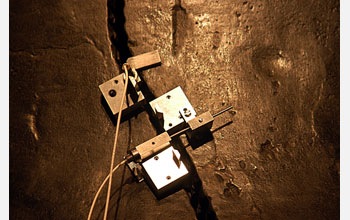Multimedia Gallery
Protecting the Liberty Bell (Image 4)
Protecting the Liberty Bell (Image 4)
A close-up view of the MicroStrain NANO-DVRT wireless sensors clamped to the Liberty Bell (the top and bottom sensors are the same design, but oriented perpendicular to each other). With even tiny motions of the crack--on the scale of millionths of a meter--the metal rod shifts its placement. The movement is detected by electrical coils, and that information is transmitted to a wireless receiver. The wires visible in this image are connecting the sensors to a wireless transmitter inside the Bell.
This sensor technology--developed in part with support from the National Science Foundation's (NSF) Small Business Innovation Research program--was used on Oct. 9, 2003, to ensure that the Liberty Bell did not sustain further damage than its already-famous crack while being moved to its new (and present) location at the National Park Service's Liberty Bell Center, 6th Street between Market and Chestnut Streets in Philadelphia. While miniscule movements were detected during the move, none caused further damage to the bell. A Vermont company, MicroStrain, provided the gauges and monitoring system for free.
To learn more about the Liberty Bell's move and it's history, see the NSF Special Report The Liberty Bell: Protecting an American Icon. (Date of Image: 2003) [One of several related images. See Next Image.]
Credit: Curt Suplee, National Science Foundation
Images and other media in the National Science Foundation Multimedia Gallery are available for use in print and electronic material by NSF employees, members of the media, university staff, teachers and the general public. All media in the gallery are intended for personal, educational and nonprofit/non-commercial use only.
Images credited to the National Science Foundation, a federal agency, are in the public domain. The images were created by employees of the United States Government as part of their official duties or prepared by contractors as "works for hire" for NSF. You may freely use NSF-credited images and, at your discretion, credit NSF with a "Courtesy: National Science Foundation" notation.
Additional information about general usage can be found in Conditions.
Also Available:
Download the high-resolution JPG version of the image. (6.4 MB)
Use your mouse to right-click (Mac users may need to Ctrl-click) the link above and choose the option that will save the file or target to your computer.



